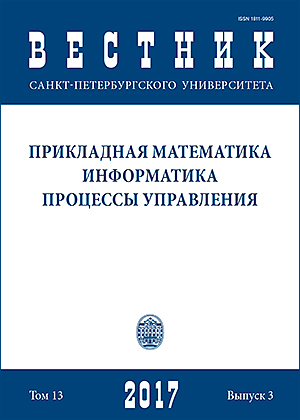Ассимиляция данных в имитационном моделировании экологических процессов методом минимизации корректирующих возмущений
DOI:
https://doi.org/10.21638/11701/spbu10.2017.309Аннотация
Оперативная коррекция текущего вектора состояния динамической модели данными прямых или косвенных измерений в режиме реального времени представляет собой известную задачу теории автоматического управления и называется проблемой ассимиляции или усвоения данных. Математические модели в экологии требуют специфических подходов к этой проблеме по сравнению с традиционными методами, применяемыми в гидрометеорологии. Основное отличие состоит в том, что в этом случае наличествуют, как правило, лишь редкие наблюдения, причем над ограниченным числом косвенных характеристик. В работе предлагается оригинальный подход к ассимиляции данных для задач подобного рода. Он заключается в том, что в исходную систему вводится дополнительное слагаемое, отражающее роль неучитываемых в идеальной модели случайных внешних воздействий. Далее находится такая форма этих возмущений, которая минимизирует взвешенную сумму их интегральной мощности и нормы отклонений наблюдаемых и теоретических характеристик в точках измерения. При этом выбор весового коэффициента позволяет отразить сравнительную степень доверия теоретической модели или фактическим измерениям. Таким образом, формальная постановка задачи записывается в виде проблемы оптимального управления. Приведены примеры применения предложенного метода для нескольких простых моделей. В задаче о равномерном движении материальной точки получено аналитическое решение, дающее, тем не менее, нетривиальные результаты. Задача об ассимиляции данных в модели Лотки—Вольтерра решена численно. Показано, что в этом случае предложенный метод «минимального возмущения» приводит к наименее «травматичнoй» коррекции эталонной модели по сравнению с известными альтернативными подходами — адаптивной идентификацией параметров или подгонкой начального состояния. Библиогр. 7 назв. Ил. 2.
Ключевые слова:
ассимиляция данных, минимизация корректирующих возмущений, экология, имитационное моделирование
Скачивания
Библиографические ссылки
References
Загрузки
Опубликован
Как цитировать
Выпуск
Раздел
Лицензия
Статьи журнала «Вестник Санкт-Петербургского университета. Прикладная математика. Информатика. Процессы управления» находятся в открытом доступе и распространяются в соответствии с условиями Лицензионного Договора с Санкт-Петербургским государственным университетом, который бесплатно предоставляет авторам неограниченное распространение и самостоятельное архивирование.





